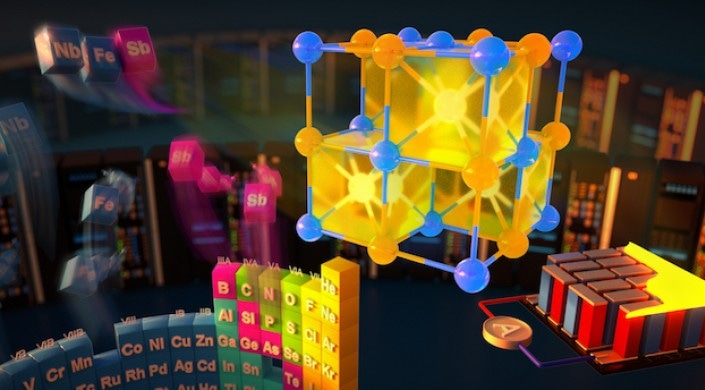May 1 2018
Nearly 60% of gasoline’s total energy is lost in the form of heat in the radiator and exhaust pipe, even in the most fuel-efficient cars. In order to overcome this, scientists have been creating innovative thermoelectric materials with the ability to transform heat into electricity. These semiconducting materials can redistribute electricity back into the vehicle and enhance the fuel efficiency by nearly 5%.
 A new algorithm uses the chemical elements in a crystal to predict its material properties. The algorithm simplifies computational required for material discovery and speeds up the process by about 10,000 times, compared to existing algorithms. (Image credit: Second Bay Studios/Harvard SEAS)
A new algorithm uses the chemical elements in a crystal to predict its material properties. The algorithm simplifies computational required for material discovery and speeds up the process by about 10,000 times, compared to existing algorithms. (Image credit: Second Bay Studios/Harvard SEAS)
However, the difficulty is that prevalent thermoelectric materials used for the recovery of waste heat are very costly and time-consuming to produce. One of the ultra-modern materials, synthesized from a mix of zirconium and hafnium—elements that are regularly used in nuclear reactors—took one and a half decades to achieve optimized performance from the time it was initially discovered.
At present, scientists at the Harvard John A. Paulson School of Engineering and Applied Sciences (SEAS) have come up with an algorithm for finding and optimizing these materials within a few months, based on solving quantum mechanical equations, without the need for experimental input.
These thermoelectric systems are very complicated. Semiconducting materials need to have very specific properties to work in this system, including high electrical conductivity, high thermopower, and low thermal conductivity, so that all that heat gets converted into electricity. Our goal was to find a new material that satisfies all the important properties for thermoelectric conversion while at the same time being stable and cheap.
Boris Kozinsky, Senior Author & Associate Professor of Computational Materials Science at SEAS
Kozinsky co-authored the study along with Georgy Samsonidze, a research engineer at the Robert Bosch Research and Technology Center in Cambridge, MA, where both carried out most of the study.
To discover such a material, the researchers developed an algorithm with the ability to predict electronic transport characteristics of a material relying only on the chemical elements used in the crystalline crystal. The solution was to simplify the computational strategy for electron-phonon scattering and to accelerate it by nearly 10,000 times more than prevalent algorithms.
The new technique and the results of the computational screening have been reported in Advanced Energy Materials.
The team employed the enhanced algorithm to screen several possible crystal structures, such as structures that had never been developed earlier. From these structures, Kozinsky and Samsonidze downsized the list to various prospective structures. They performed further computational optimization of the prospective structures and sent the best ones to the experimental team.
In a prior attempt, experimentalists produced the best structures indicated by these computations and zeroed in on a material with stability and efficiency similar to the thermoelectric materials but 10 times inexpensive. It took only 15 months from the initial screening to developing the working devices.
We did in 15 months of computation and experimentation what took 15 years for previous materials to be optimized. What’s really exciting is that we’re probably not fully understanding the extent of the simplification yet. We could potentially make this method even faster and cheaper.
Boris Kozinsky, Senior Author & Associate Professor of Computational Materials Science at SEAS
Kozinsky is hopeful that the new technique can be enhanced and used to probe electronic transport in a broader category of innovative, remarkable materials such as topological insulators.
The U.S. Department of Energy and Robert Bosch LLC supported this study.